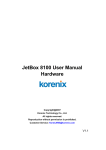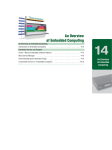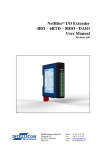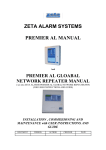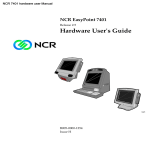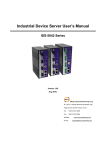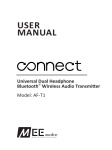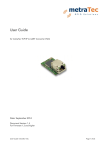Download Rcore3D-Blue-forPDF.fh11
Transcript
Take advantage of Moxa's Rcore platform to increase your competitiveness and ensure a faster time-to-market. The Rcore platform provides the following hard-to-beat benefits: Easy-to-use application libraries Consulting-level advice for application development Proven and bug-free sample code Fast concept validation and development cycle Moxa's x86 and RISC-based embedded computers offer a powerful computing environment and stable system for a variety of industrial applications. These computers use either a Linux or Windows (CE and XPe) embedded operating system to provide programmers around the world with a user-friendly environment for application development, and help reduce the effort required for system integration. Moxa continues to look for real-time operating systems that are suitable for mission critical applications. Moxa offers a variety of middleware to help you easily integrate these application modules into your system. This is essential for leveraging the key features of these modules and reducing the effort required for application development. The VPN (OpenVPN, L2TP, and IPSec) middleware makes it easy for user applications to create secure tunnels between communication parties. The firewall (iptable) middleware protects enterprise information from un-friendly access. The database system (MySQL and MSSQL) middleware can be used to manage field-data acquisition, with web services (Web, PHP, ASP) included to give programmers an integration framework for building Internet accessible field applications, such as WebSCADA. To lower customers' development cost, Moxa provides sample code for a wide range of embedded applications, such as serial-to-Ethernet (S2E), serial-to-serial (S2S), and Modbus TCP and RTU. This high-level sample code or application libraries hide the details of implementing complex data communication by presenting relatively simple function prototypes for user applications. In addition, low-level libraries that manage direct access to peripheral I/O devices, such as LCM, key pad, digital IO Moxa provides a Windows PC-based tool (MDM) that autodetects, configures, and manages Moxa's embedded computers over an Internet environment. This tool provides features for setting IP addresses, managing files, monitoring 02 signals, and watchdog functions, are also included. With ready access to such a rich assortment of embedded applications, programmers obtain a much greater flexibility than would otherwise be possible. These libraries help programmers quickly grasp the full functionality of their applications, and in this way gain the confidence needed to complete their project, essentially speeding up product development and ensuring that code is efficient and bug-free. memory usage of computers, and helping application developers deploy their programs en masse to an entire army of computers. Open Source Linux architecture for easy development The pre-installed Linux OS provides an open source software operating system for your software development. This means that software written for the desktop PC is easily ported to Moxa's embedded computers by performing a GNU cross compiler without needing to modify the code. Source level debugging Moxa's embedded computers (UC-7400 Series, UC-7400 Plus Series, DA-660 Series, IA240 Series, IA260 Series, and UC-8410 Series) have a built-in GDB server that enables software developers to use freeware, such as DDD in Linux environments, for source level debugging. Embedded web server for web applications Moxa's embedded computers have a pre-installed web server daemon that lets you set up your web application easily. Edit your web application with any familiar web tool, and then download the site to the Moxa embedded computer, and enjoy the benefits of web applications that are viewable with any popular web browser. Robust self-recovery file system Moxa's embedded computers provide a self-recovery file system to ensure reliable operation. There are two file systems inside. One is the User File System, and the other is a Mini File System. If mounting the user file system fails, Moxa's embedded computers will auto-boot from the Mini File System to ensure a successful boot-up. In addition to being part of the Linux community, the Moxa embedded computer family also includes models running the Microsoft® Windows® Embedded operating system. Adopting a widely used programming environment makes our embedded computers suitable for software development and legacy system migration. Easier Application Development with IDE Tools Software written for the desktop PC can be easily ported to a Moxa embedded computer with very little or even no modifications. Both porting and new development can be done using any number of friendly Integrated Development Environment (IDE) tools. Choose the tools based on the application language you plan to use and install them on your development PC. For detailed installation steps, please refer to the user's manual. 03 C/C++ Applications: Using Embedded Visual C++ (eVC) 4.0 Using Visual Studio 2005 or Visual Studio 2008 The eVC 4.0 tools can be downloaded for free from MSDN's download page. Install the eVC 4.0 tools and import service pack 4. Note that eVC is used for CE versions under 5.0. Microsoft Visual Studio 2005/2008 is a complete set of development tools for building C/C++ applications. You can develop WinCE applications with the Moxa SDK using Visual Studio 2005/2008 for WinCE 5.0/6.0/XPe. VB.NET/C# Applications: Using Visual Studio 2005 or Visual Studio 2008 Microsoft Visual Studio 2005/2008 is a complete set of development tools for building ASP.NET Web applications, XML Web services, and mobile applications. Visual Basic, Visual C++, Visual C#, and Visual J# (XPe only) all use the same IDE, which allows them to share tools and facilities when creating mixed-language solutions. If you are building applications under WinCE, after installing the IDE tool you will also need to install a Windows Embedded SDK (provided by Moxa) on your development PC. After doing so, the SDK will be integrated with your IDE tool. The Win CE SDK includes C libraries and run-time libraries, Microsoft Foundation Classes (MFC), SOAP Toolkit, .NET Compact Framework, XML, and Winsock for you to develop your applications. Unbeatable middleware for integrating application modules into proprietary systems VPN Middleware makes it easy for users to create secure tunnels between communication parties Virtual Private Network (VPN) A Virtual Private Network (VPN) allows the provisioning of private network services for an organization or organizations over a public infrastructure, such as the Internet, instead of with physical wires. The network is said to be "virtual" because it links two "physical" networks (local area networks) using an unreliable connection (the Internet), and "private" because only computers that belong to a local area network on either end of the VPN can "see" the data. The technologies introduced today are applied to IP-based VPNs rather than frame relay or ATM networks. OpenVPN OpenVPN is one of the virtual private network (VPN) solutions that establish secure tunnels between host computers. Two networking techniques are supported by OpenVPN: Ethernet bridging and IP routing. Moxa provides a ready-to-run OpenVPN middleware to enable Moxa embedded computers to be used as OpenVPN gateways with IP routing capability. IPsec Protocol Internet Protocol Security (IPsec) is a suite of protocols for securing Internet Protocol (IP) communications by authenticating and/or encrypting each IP packet in a data stream. IPsec protocols provide a set of security services to create secure channels between a pair of security gateways, such as a router or a firewall. Since IPsec provides reliable encryption, integrity, authentication, and replay protection, adding IPsec to Moxa's embedded computers helps prevent threats from intruders. Openswan Openswan is an implementation of Internet Protocol Security (IPsec) for Linux platforms. Moxa provides Openswan configuration examples for integrators who want to use RSA (Asymmetric key cryptography) and PSK 04 (Symmetric key cryptography) authentication algorithms to create host-to-host, subnet-to-subnet, or host-to-subnet IPsec connections. In addition to being part of the Linux community, the Moxa embedded computer family also includes models running the Microsoft® Windows® Embedded operating system. Adopting a widely used programming environment makes our embedded computers suitable for software development and legacy system migration. LCM The LCM Programming function helps developers easily program LCM displays on the UC-7410/7420 and DA-660 series computers. Keypad The Keypad Programming function helps developers easily program keypad buttons on the UC-7410/7420 and DA-660 series computers. In addition to the primary function, additional API functions are provided, such as a callback function defined by programmers to associate with an event. Socket Moxa embedded computers come with network interfaces that allow client-server applications to communicate with each other across a computer network. A Socket Programming function helps developers implement socket programming with TCP or UDP protocols. Serial In addition to the primary Serial Port Programming function, Moxa embedded computers offer higher level APIs for serial connections. Real Time Clock Developers can use the RTC Programming function to get the current time, set the hardware clock time to a specified time, set the hardware clock time to the system time, and set the system time from the hardware clock, by use of the function sample codes. Buzzer A Buzzer Programming function allows developers to trigger alarm beeps for unusual events. Watchdog Timer Moxa's embedded computers are also equipped with a Watchdog Timer Programming function that sets the system back to normal if applications don't acknowledge. 05 06 Systems that incorporate several devices located at remote sites present a big challenge to solution providers. This is particularly true for industrial applications that use several headless embedded computers distributed over a wide area. Although this type of computer is generally accessible from over the network, the existing remote management options present a rather clumsy solution for managing large numbers of embedded computers. Perhaps the most common method of managing embedded computers remotely over the network is to use Telnet/SSH. However, one of the main drawbacks to this type of management is that you can only connect to one embedded computer at a time. In addition, the administrator must actively type in the IP address of the embedded computer to establish the Telnet/SSH connection. It can be a real nightmare to keep track of which IP address is associated with which embedded computer. Another method of managing an embedded computer includes working from the command line. Although this can be done from over the network, most administrators find it difficult to remember all of the commands that are required to manage files and run programs. Script files that combine several commands in one text file can be used to automate the command line method, but this option can also be quite time-consuming for administrators that manage tens if not hundreds of machines. Moxa Device Manager (MDM for short) is an easy-to-use remote management tool for managing Moxa's ready-torun embedded computers over the Internet. Moxa's embedded computers make excellent front-end computers at remote sites for on-site data collection and industrial control applications. MDM is designed to make it easy for system administrators to manage their remote embedded computers. One of the key benefits of MDM is that management tasks, such as configuring the network, managing and/or transmitting text and binary files, and monitoring and controlling processes, can be handled easily using a Windows-based user interface. In addition, MDM can be used to manage different models of embedded computers, and embedded computers that use different operating systems, all from one centrally located computer. As long as the individual embedded computers are preinstalled with an MDM agent, they can be recognized and managed by the unified MDM tool from your PC. These features help ensure that MDM gives system integrators an efficient tool for handling all remote devices from one computer. In addition to controlling heterogeneous computer systems, the traffic between the MDM tool and any of the MDM agents is encrypted. This feature protects data transmitted from the system. Users can comfortably manage the remote devices without worrying about the usual risks associated with transmitting data over a network. Remote Control and Management Easy Installation and Setup Supports all models of Moxa's embedded computers and Linux, WinCE, WinXPe operating systems An MDM Agent program running on an embedded computer can be started automatically at boot-up Control and monitor remote embedded units over the Internet MDM Tool and Gateway can be installed on any PC running Windows XP Broadcast search for Moxa embedded computers on the same LAN Command-line Free Configuration and Maintenance Get instant device status Launch programs automatically when booting up List basic information (IP, Model, Firmware version, OS, hostname, CPU, product image, memory information, and storage information) of all devices on the main page One-to-multiple file transfers Perform remote file system management Configure network interfaces Monitor and kill processes Easy-to-use User Interface User-friendly "click and operate" interface for remote device management Friendly windows-based utilities for easy configuration Moxa Device Manager comes with MDM Agent, MDM Tool, and MDM Gateway. Users can download the Moxa Device View detailed system information Reboot devices Upgrade firmware for multiple devices at one time Update system time Manager package from the "Support --> Software" page on Moxa's website. 07 Web-based Management System Moxa's embedded computers are network-centric programmable platforms designed to be used as front-end computers for data acquisition and industrial control. The embedded computer is often located away from the system administrator in the same harsh environment as the controlled devices. This makes the task of managing the computer remotely an important aspect of the embedded computer's operation. To resolve this remote management issue and reduce the work load of the system administrator, the Moxa embedded computer is installed with a Web-based management system. The system incorporates often-used features into an internal site and categorizes the features on a menu bar, as shown in the accompanying figures. System Information Networking/Server Configuration Process (Thread) Monitoring/Control Services Monitoring/Control Binary/Text File Management and Upload This web-based management system allows you to manage web sites, the registry database for system and application programs, and many other aspects of the computer's operation. Become a member and get more details at: www.moxa.com [email protected] Toll-free: 1-888-MOXA-USA (1-888-669-2872) Tel: +1-714-528-6777 Fax: +1-714-528-6778 www.moxausa.com [email protected] Shanghai Office Tel: +86-21-5258-9955 Fax: +86-21-5258-5505 www.moxa.com.cn [email protected] Beijing Office Tel: +49-89-3 70 03 99-0 Fax: +49-89-3 70 03 99-99 www.moxa.com [email protected] Tel: +86-10-6872-3959/60/61 Fax: +86-10-6872-3958 www.moxa.com.cn [email protected] Shenzhen Office Tel: +886-2-8919-1230 Fax: +886-2-8919-1231 www.moxa.com [email protected] P/N: 1900030901010 Tel: +86-755-8368-4084/94 Fax: +86-755-8368-4148 www.moxa.com.cn [email protected] ©2009 Moxa Inc., all rights reserved. The Moxa logo is a registered trademark of Moxa Inc. All other logos appearing in this catalog are the intellectual property of the respective company, product, or organization associated with the logo.










